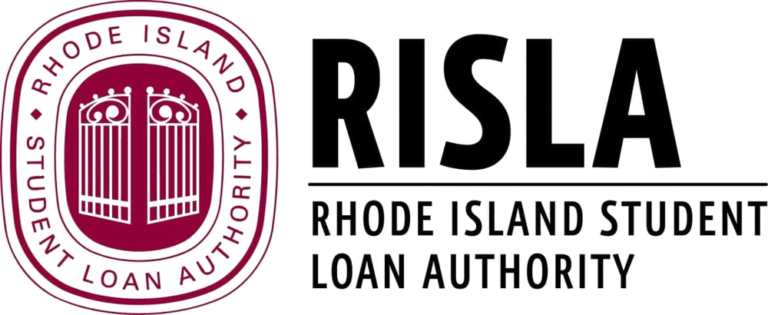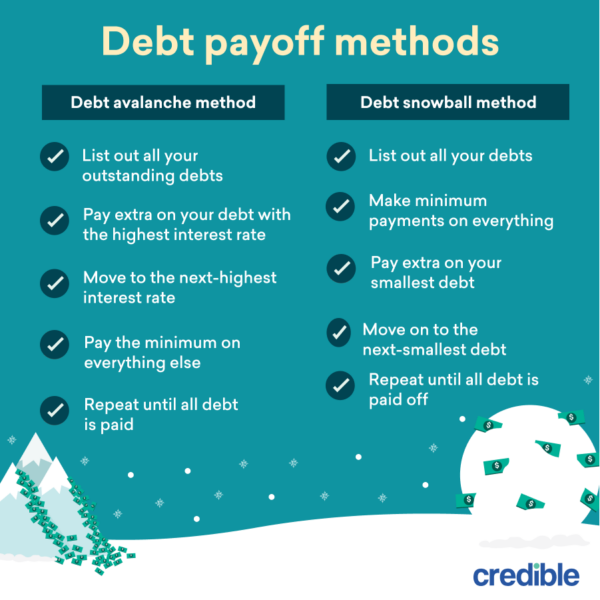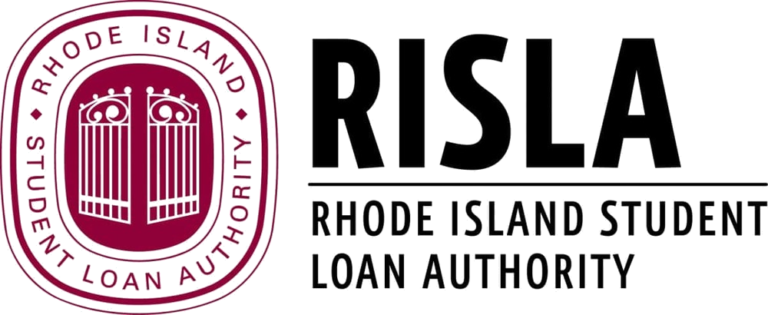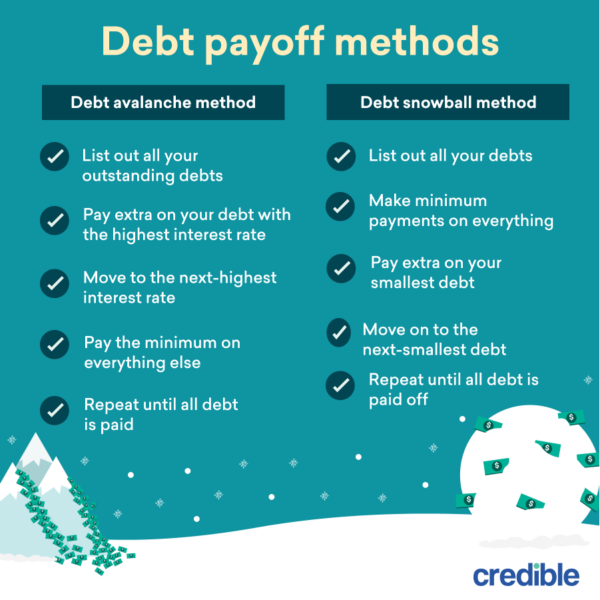How to Pay Off $80,000 in Student Loans
Paying for college can be expensive. While the average student loan debt for college students is $39,351, it isn’t uncommon for students to leave school with $80,000 or more in education debt.
Tackling this amount of student loan debt can be difficult and time consuming. For example, if you had $80,000 in federal student loans made payments on the standard 10-year repayment plan with a 6.22% interest rate, you’d end up with a monthly payment of $897 and a total repayment cost of $107,643.
The good news is that there are multiple strategies that could help you pay off $80,000 in student loans more easily — and sometimes, more quickly as well.
Here are five ways to pay off $80,000 in student loans:
Refinance your student loansConsider using a cosigner when refinancingExplore income-driven repayment plansPursue loan forgiveness for federal student loansAdopt the debt avalanche or debt snowball method
1. Refinance your student loans
If you refinance your student loans, you’ll take out a new private loan to pay off your old loans, leaving you with just one loan and payment to manage. Depending on your credit, you might qualify for a lower interest rate through refinancing — this could save you hundreds or even thousands of dollars on interest as well as potentially help you pay off your loans faster.
Or you could opt to extend your repayment term to reduce your monthly payments and lessen the strain on your budget. Just keep in mind that by choosing a longer term, you’ll pay more in interest over time.
Keep in mind: While you can refinance both federal and private loans, refinancing federal student loans will cost you access to federal benefits and protections — such as income-driven repayment plans and student loan forgiveness programs.
If you decide to refinance your student loans, be sure to consider as many lenders as possible to find the right loan for you. Credible makes this easy — you can compare your prequalified rates from our partner lenders in the table below in just two minutes.
LenderFixed rates from (APR)Variable rates from (APR)Loan terms (years)Loan amounts

Credible Rating>
Credible lender ratings are evaluated by our editorial team with the help of our loan operations team. The rating criteria for lenders encompass 78 data points spanning interest rates, loan terms, eligibility requirement transparency, repayment options, fees, discounts, customer service, cosigner options, and more. Read our full methodology.
View details>
4.54%+N/A10, 15, 20$7,500 up to up to $200,000
(larger balances require special approval)Fixed APR:
4.54%+Variable APR:
N/AMin. credit score:
Does not discloseLoan amount:
$7,500 up to $500,000Loan terms (years):
10, 15, 20Max. undergraduate loan balance:
$250,000 – $500,000Time to fund:
4 monthsRepayment options:
Immediate repayment, forbearance, loans discharged upon death or disabilityFees:
NoneDiscounts:
AutopayEligibility:
Must be a resident of KentuckyCustomer service:
PhoneSoft credit check:
NoCosigner release:
After 36 monthsLoan servicer:
Kentucky Higher Education Student Loan CorporationMax. graduate loan balance:
$250,000 – $500,000Credible Review:
Advantage Education Loan reviewOffers Parent PLUS Refinancing :
Yes

Credible Rating>
Credible lender ratings are evaluated by our editorial team with the help of our loan operations team. The rating criteria for lenders encompass 78 data points spanning interest rates, loan terms, eligibility requirement transparency, repayment options, fees, discounts, customer service, cosigner options, and more. Read our full methodology.
View details>
2.15%+
1.87%+5, 7, 10, 15, 20$10,000 up to $250,000
(depending on degree)Fixed APR:
2.15%+Variable APR:
N/AMin. credit score:
Does not discloseLoan amount:
$10,000 to $400,000Loan terms (years):
5, 7, 10, 15, 20Repayment options:
Military deferment, forbearanceFees:
Late feeDiscounts:
AutopayEligibility:
Must have a credit score of at least 720, a minimum income of $60,000, and must be a resident of TexasCustomer service:
Email, phoneSoft credit check:
Does not discloseCosigner release:
NoLoan servicer:
Firstmark ServicesMax. Undergraduate Loan Balance:
$100,000 – $149,000Max. Graduate Loan Balance:
$200,000 – $400,000Offers Parent PLUS Refinancing:
Does not disclose

Credible Rating>
Credible lender ratings are evaluated by our editorial team with the help of our loan operations team. The rating criteria for lenders encompass 78 data points spanning interest rates, loan terms, eligibility requirement transparency, repayment options, fees, discounts, customer service, cosigner options, and more. Read our full methodology.
View details>
2.44%+1
2.24%+15, 7, 10, 15, 20$10,000 to $500,000
(depending on degree and loan type)Fixed APR:
2.44%+1Variable APR:
2.24%+1Min. credit score:
Does not discloseLoan amount:
$10,000 to $750,000Loan terms (years):
5, 7, 10, 15, 20Repayment options:
Immediate repayment, academic deferment, military deferment, forbearance, loans discharged upon death or disabilityFees:
Late feeDiscounts:
Autopay, loyaltyEligibility:
Must be a U.S. citizen or permanent resident and have at least $10,000 in student loansCustomer service:
Email, phone, chatSoft credit check:
YesCosigner release:
After 24 to 36 monthsLoan servicer:
Firstmark ServicesMax. Undergraduate Loan Balance:
$100,000 to $149,000Max. Graduate Loan Balance:
Less than $150,000Offers Parent PLUS Refinancing:
Yes

Credible Rating>
Credible lender ratings are evaluated by our editorial team with the help of our loan operations team. The rating criteria for lenders encompass 78 data points spanning interest rates, loan terms, eligibility requirement transparency, repayment options, fees, discounts, customer service, cosigner options, and more. Read our full methodology.
View details>
2.99%+2
2.94%+25, 7, 10, 12, 15, 20$5,000 to $300,000
(depending on degree type)Fixed APR:
2.99%+2Variable APR:
2.94%+2Min. credit score:
Does not discloseLoan amount:
$5,000 to $300,000Loan terms (years):
5, 7, 10, 12, 15, 20Repayment options:
Military deferment, forbearance, loans discharged upon death or disabilityFees:
Late feeDiscounts:
AutopayEligibility:
All states except for MECustomer service:
Email, phone, chatSoft credit check:
YesCosigner release:
After 24 to 36 monthsLoan servicer:
College Ave Servicing LLCMax. Undergraduate Loan Balance:
$100,000 to $149,000Max. Graduate Loan Balance:
Less than $300,000Offers Parent PLUS Refinancing:
Yes

Credible Rating>
Credible lender ratings are evaluated by our editorial team with the help of our loan operations team. The rating criteria for lenders encompass 78 data points spanning interest rates, loan terms, eligibility requirement transparency, repayment options, fees, discounts, customer service, cosigner options, and more. Read our full methodology.
View details>
2.16%+
2.11%+5, 7, 10, 15, 20$5,000 to $500,000Fixed rate:
2.44%+1Variable rate:
2.24%+1Min. credit score:
680Loan amount:
$5,000 to $500,000Cosigner release:
YesLoan terms (years):
5, 7, 10, 15, 20Repayment options:
Academic deferment, forbearance, loans discharged upon death or disabilityFees:
Late feeDiscounts:
AutopayEligibility:
Available in all states, except MS and NVCustomer service:
Email, phone, chatSoft credit check:
YesLoan servicer:
FirstMarkMax. undergraduate loan balance:
$500,000Max. graduate loan balance:
$500,000Offers Parent PLUS refinancing:
YesMin. income:
$65,000 (for 15- and 20-year products)

Credible Rating>
Credible lender ratings are evaluated by our editorial team with the help of our loan operations team. The rating criteria for lenders encompass 78 data points spanning interest rates, loan terms, eligibility requirement transparency, repayment options, fees, discounts, customer service, cosigner options, and more. Read our full methodology.
View details>
1.8%+5
1.8%+55, 10, 15, 20$1,000 to $250,000Fixed APR:
1.8%+5Variable APR:
1.8%+5Min. credit score:
700Loan amount:
$7,500 to $200,000Loan terms (years):
5, 10, 15, 20Repayment options:
Immediate repayment, academic deferment, forbearance, loans discharged upon death or disabilityFees:
NoneDiscounts:
AutopayEligibility:
Must be a U.S. citizen or permanent resident and submit two personal referencesCustomer service:
Email, phoneSoft credit check:
YesCosigner release:
After 36 monthsLoan servicer:
Granite State Management & Resources (GSM&R)Max. Undergraduate Loan Balance:
$150,000 to $249,000Max. Graduate Loan Balance:
$150,000 to $199,000Offers Parent PLUS Refinancing :
Yes

Credible Rating>
Credible lender ratings are evaluated by our editorial team with the help of our loan operations team. The rating criteria for lenders encompass 78 data points spanning interest rates, loan terms, eligibility requirement transparency, repayment options, fees, discounts, customer service, cosigner options, and more. Read our full methodology.
View details>
2.47%+3
2.39%+35, 7, 10, 12, 15, 20Minimum of $15,000Fixed APR:
2.47%+3Variable APR:
2.39%+3Min. credit score:
680Loan amount:
No maximumLoan terms (years):
5, 7, 10, 12, 15, 20Repayment options:
ForbearanceFees:
NoneDiscounts:
NoneEligibility:
Must be a U.S. citizen or permanent resident, have at least $15,000 in student loan debt, and have a bachelor’s degree or higher from an approved schoolCustomer service:
Email, phoneSoft credit check:
YesCosigner release:
NoLoan servicer:
MohelaMax. Undergraduate Loan Balance:
No maximumMax. Graduate Loan Balance:
No maximumOffers Parent PLUS Refinancing:
Yes

Credible Rating>
Credible lender ratings are evaluated by our editorial team with the help of our loan operations team. The rating criteria for lenders encompass 78 data points spanning interest rates, loan terms, eligibility requirement transparency, repayment options, fees, discounts, customer service, cosigner options, and more. Read our full methodology.
View details>
3.47%+4
2.44%+45, 10, 15, 20$5,000 – $250,000Fixed APR:
3.47%+4Variable APR:
2.44%+4Min. credit score:
670Loan amount:
$5,000 to $250,000Loan terms (years):
5, 10, 15, 20Repayment options:
Academic deferment, military deferment, forbearanceFees:
Late feeDiscounts:
AutopayEligibility:
Must be U.S. citizen or permanent residentCustomer service:
Email, phone, chatSoft credit check:
YesCosigner release:
YesMax undergraduate loan balance:
$250,000Max graduate loan balance:
$250,000Offers Parent PLUS refinancing:
Yes

Credible Rating>
Credible lender ratings are evaluated by our editorial team with the help of our loan operations team. The rating criteria for lenders encompass 78 data points spanning interest rates, loan terms, eligibility requirement transparency, repayment options, fees, discounts, customer service, cosigner options, and more. Read our full methodology.
View details>
2.24%+7N/A5, 7, 10, 12, 15, 20Up to $300,000Fixed APR:
2.24%+7Variable APR:
N/AMin. credit score:
670Loan amount:
Up to $300,000Loan terms (years):
5, 7, 10, 15, 20Time to fund:
Usually one business dayRepayment options:
Academic deferral, military deferral, forbearance, death/disability dischargeFees:
NoneDiscounts:
AutopayEligibility:
Available in all 50 statesCustomer service:
Email, phoneSoft credit check:
YesCosigner release:
After 24 monthsMax. undergraduate loan balance:
$300,000Max. graduate balance:
$300,000Offers Parent PLUS loans:
YesMin. income:
None

Credible Rating>
Credible lender ratings are evaluated by our editorial team with the help of our loan operations team. The rating criteria for lenders encompass 78 data points spanning interest rates, loan terms, eligibility requirement transparency, repayment options, fees, discounts, customer service, cosigner options, and more. Read our full methodology.
View details>
3.05%+
3.05%+7, 10, 15$10,000 up to the total amount of qualified education debtFixed APR:
3.05%+Variable APR:
3.05%+Min. credit score:
670Loan amount:
$10,000 up to the total amountLoan terms (years):
7, 10, 15Repayment options:
Military deferment, loans discharged upon death or disabilityFees:
NoneDiscounts:
NoneEligibility:
Must be a U.S. citizen or permanent resident and have at least $10,000 in student loansCustomer service:
Email, phoneSoft credit check:
YesCosigner release:
NoLoan servicer:
AESMax. Undergraduate Loan Balance:
No maximumMax. Gradaute Loan Balance:
No maximumOffers Parent PLUS Refinancing:
Yes

Credible Rating>
Credible lender ratings are evaluated by our editorial team with the help of our loan operations team. The rating criteria for lenders encompass 78 data points spanning interest rates, loan terms, eligibility requirement transparency, repayment options, fees, discounts, customer service, cosigner options, and more. Read our full methodology.
View details>
2.89%+N/A5, 8, 12, 15$7,500 to $300,000Fixed APR:
2.89%+Variable APR:
N/AMin. credit score:
670Loan amount:
$7,500 to $300,000Loan terms (years):
5, 8, 12, 15Repayment options:
Does not discloseFees:
NoneDiscounts:
NoneEligibility:
Must be a U.S. citizen and have and at least $7,500 in student loansCustomer service:
Email, phone, chatSoft credit check:
YesCosigner release:
After 12 monthsLoan servicer:
PenFedMax. Undergraduate Loan Balance:
$300,000Max. Graduate Loan Balance:
$300,000Offers Parent PLUS Refinancing:
Yes

Credible Rating>
Credible lender ratings are evaluated by our editorial team with the help of our loan operations team. The rating criteria for lenders encompass 78 data points spanning interest rates, loan terms, eligibility requirement transparency, repayment options, fees, discounts, customer service, cosigner options, and more. Read our full methodology.
View details>
2.69%+N/A5, 10, 15$7,500 up to $250,000
(depending on highest degree earned)Fixed APR:
2.69%+Variable APR:
N/AMin. credit score:
680Loan amount:
$7,500 to $250,000Loan terms (years):
5, 10, 15Repayment options:
Academic deferment, military deferment, forbearance, loans discharged upon death or disabilityFees:
NoneDiscounts:
AutopayEligibility:
Available in all 50 states; must also have at least $7,500 in student loans and a minimum income of $40,000Customer service:
Email, phoneSoft credit check:
Does not discloseCosigner release:
NoLoan servicer:
Rhode Island Student Loan AuthorityMax. Undergraduate Loan Balance:
$150,000 – $249,000Max. Graduate Loan Balance:
$200,000 – $249,000Offers Parent PLUS Refinancing:
Yes

Credible Rating>
Credible lender ratings are evaluated by our editorial team with the help of our loan operations team. The rating criteria for lenders encompass 78 data points spanning interest rates, loan terms, eligibility requirement transparency, repayment options, fees, discounts, customer service, cosigner options, and more. Read our full methodology.
View details>
2.49%+6
1.99%+65, 7, 10, 15, 20$5,000 up to the full balance of your qualified education loansFixed APR:
2.49%+6Variable APR:
1.99%+6Min. credit score:
Does not discloseLoan amount:
$5,000 up to the full balanceLoan terms (years):
5, 7, 10, 15, 20Repayment options:
Academic deferment, military defermentFees:
NoneDiscounts:
Autopay, loyaltyEligibility:
Available in all 50 statesCustomer service:
Email, phone, chatSoft credit check:
YesCosigner release:
NoMax undergraduate loan balance:
No maximumMax graduate loan balance:
No maximumOffers Parent PLUS refinancing:
YesCompare personalized rates from multiple lenders without affecting your credit score. 100% free!
Compare Now
Trustpilot
All APRs reflect autopay and loyalty discounts where available | 1Citizens Disclosures | 2College Ave Disclosures | 5EDvestinU Disclosures | 3 ELFI Disclosures | 4INvestEd Disclosures | 7ISL Education Lending Disclosures | 6SoFi Disclosures
2. Consider using a cosigner when refinancing
Most lenders require you to have good to excellent credit to qualify for student loan refinancing — a good credit score is usually considered to be 700 or higher. There are also several lenders that offer refinancing for bad credit, but these loans typically have higher interest rates compared to good credit loans.
If you have poor credit and are struggling to get approved, consider applying with a creditworthy cosigner to improve your chances. Even if you don’t need a cosigner to qualify, having one could get you a lower interest rate than you’d get on your own.
Tip: A cosigner can be anyone with good credit who is willing to share responsibility for the loan. For example, you could ask a parent, another relative, or a trusted friend to cosign.
Just keep in mind that if you can’t make your payments, your cosigner will be liable — this could also damage their credit.
Learn More: Best Student Refinance Companies: Reviewed and Rated
3. Explore income-driven repayment plans
If you have federal student loans, signing up for an income-driven repayment (IDR) plan could make your loan payments easier to manage. On an IDR plan, your payments are based on your income — usually 10% to 20% of your discretionary income. Additionally, you could have any remaining balance forgiven after 20 to 25 years, depending on the plan.
Here’s how the four main IDR plans compare to a few other federal repayment plan options:
Repayment planWho’s eligible?Monthly paymentRepayment termsEligible for loan forgiveness?Standard repayment planAny borrower with Direct or FFEL LoansAmount when payments are spread equally over 10 years (usually $50 minimum) 10 yearsNoGraduated repayment planAny borrower with Direct or FFEL LoansDepends on loan amount
(payments start low and increase every 2 years)10 yearsNoExtended repayment planAny borrower with more than $30,000 in Direct or FFEL LoansFixed: Spread evenly over up to 25 years
Graduated: Depends on loan amount (start low and increase every 2 years)Up to 25 yearsNoIncome-Based Repayment (IBR)Borrowers with partial financial hardship
(no Parent PLUS Loans)For borrowers who took out loans after July 1, 2014: 10% of discretionary income
(never more than 10-year plan)
For borrowers who took out loans before July 1, 2014: 15% of discretionary income
(never more than 10-year plan)For borrowers who took out loans after July 1, 2014: 20 years
For borrowers who took out loans before July 1, 2014: 25 yearsYesPay As You Earn (PAYE)Must have partial financial hardshipMust have borrowed on or after Oct. 1, 200710% of discretionary income
(never more than 10-year plan)20 yearsYesRevised Pay As You Earn (REPAYE)Any borrower
(no Parent PLUS Loans)10% of discretionary income
(no cap)20 years
(25 years if repaying grad school debt)YesIncome Contingent Repayment (ICR)Any borrower
(Parent PLUS Loans must be consolidated)20% of discretionary income
(or income-adjusted payment on 12-year plan)25 yearsYes
Check Out: PAYE vs. REPAYE: Which Repayment Plan Is Right for You?
4. Pursue loan forgiveness for federal student loans
There are several forgiveness programs available to federal student loan borrowers. These programs generally require you to be employed in a certain field and to make qualifying payments for a specific period of time.
For example: If you work for a nonprofit or government organization, you might be eligible for Public Service Loan Forgiveness (PSLF) after making qualifying payments for 10 years.
Other professions that might qualify for federal forgiveness programs include:
DentistsDoctorsLawyers NursesPharmacistsTeachersKeep in mind: Unfortunately, private student loan forgiveness doesn’t exist. However, there are other options that could help you more easily repay your private loans — such as refinancing.
Learn More: Private Student Loan Consolidation
5. Adopt the debt avalanche or debt snowball method

There are also some situations where you might simply have to concentrate on paying off your loans as quickly as possible — such as if you have multiple loans and aren’t eligible for forgiveness. Here are a couple of payoff strategies that could help:
Debt avalanche method
With the debt avalanche method, you’ll focus on paying off your loan with the highest interest rate first while making the minimum payments on your other loans.
Once this first loan is paid off, you’ll move on to the loan with the next-highest interest rate — continuing until all of your loans are repaid.
Tip: The debt avalanche method can help you save money on interest — but it can also take a while to see your results. If you’re more motivated by small wins, you might want to consider the debt snowball method instead.
Debt snowball method
With the debt snowball method, you’ll target your smallest loan first as you continue making the minimum payments on your other loans.
After this first loan is repaid, you’ll move on to the next-smallest loan — continuing until all of your loans have been paid off.
Tip: The debt snowball method typically provides faster results than the debt avalanche, which can provide motivation through your payoff journey.
But if you don’t mind waiting to experience a win and want to save more on interest, the debt avalanche method might be a better fit.
Check Out: How Often Can You Refinance Student Loans?
Frequently asked questions
Here are the answers to a few commonly asked questions about paying off $70,000 in student loans:
How long does it take to pay off $70,000 in student loans?
This will mainly depend on the type of student loans you have and your repayment plan.
Federal student loans: Depending on the repayment plan you choose, it could take 10 to 25 years to repay your federal loans. You could also choose to consolidate your loans into a Direct Consolidation Loan and extend your term up to 30 years.Private student loans: Repayment terms on private loans usually range from five to 20 years, depending on the lender. You might also be able to reduce your repayment time by refinancing to a shorter term or by making extra payments on your loans.
Can I file for bankruptcy to eliminate my student loan debt?
Yes, you can file bankruptcy for student loan debt. However, it could be hard to actually have your loans discharged. If you file for Chapter 7 or Chapter 13 bankruptcy, you’ll have to prove to the court that repaying your loans would cause an undue hardship for you and your dependents.
If the court decides in your favor, your loans could be:
Fully dischargedPartially discharged with you responsible for the remainder of the balanceAdjusted with different terms to make repayment easier (such as a lower interest rate)Tip: Bankruptcy will severely damage your credit and should be considered a last resort. If you’re thinking about filing for bankruptcy, it’s a good idea to discuss your situation with a lawyer first so you can be sure it’s the right decision for your finances.
re student loans forgiven after 20 years?
This depends on the type of loans you have.
If you have federal student loans and sign up for an IDR plan, you could have any remaining balance forgiven after 20 to 25 years. There are also other programs that offer forgiveness sooner — for example, if you’re eligible for PSLF, you could have your loans forgiven after 10 years.If you have private student loans, you aren’t eligible for forgiveness. If you have good credit, it could be a good idea in this case to refinance for a lower interest rate so you can save money on interest and possibly shorten your repayment time.
Do children inherit student debt?
Typically no. Here’s what generally happens with student loan debt after death:
Federal student loans are discharged upon the death of the primary borrower. If you have a Parent PLUS Loan, it will be discharged if you or the student who benefitted from it passes away.
Private student loans are often discharged similarly to federal loans — though keep in mind that this is at the discretion of the lender. If the lender doesn’t discharge the loans, they’ll be considered part of your estate and paid off by your assets.
The post How to Pay Off $80,000 in Student Loans appeared first on Credible.
How to Pay Off $70,000 in Student Loans
While the average student loan debt for college students is $39,351, some students might end up leaving school with $70,000 or more in student loans.
Paying off this amount in student loans can feel overwhelming. For example, if you had $70,000 in federal student loans and made payments under the standard 10-year repayment plan with a 6.22% interest rate, you’d end up with a monthly payment of $785 and a total repayment cost of $94,188.
Thankfully, there are several strategies that could help you more easily manage $70,000 in student loans.
Here’s how to pay off $70,000 in student loans:
Refinance your student loansConsider using a cosigner when refinancingExplore income-driven repayment plansPursue loan forgiveness for federal student loansAdopt the debt avalanche or debt snowball method
1. Refinance your student loans
Student loan refinancing is the process of paying off your old loans with a new loan. Depending on your credit, you might get a lower interest rate through refinancing, which could save you money on interest and even potentially help you pay off your loans faster.
Or you could opt to extend your repayment term to reduce your monthly payments and lessen the strain on your budget — though keep in mind that this means you’ll pay more in interest over time.
Keep in mind: You can refinance both federal and private loans. However, refinancing your federal student loans will cost you access to federal benefits and protections — such as income-driven repayment plans and student loan forgiveness programs.
If you decide to refinance your student loans, be sure to consider as many lenders as possible so you can find the right loan for your situation. Credible makes this easy — you can compare your prequalified rates from our partner lenders in the table below in just two minutes.
LenderFixed rates from (APR)Variable rates from (APR)Loan terms (years)Loan amounts

Credible Rating>
Credible lender ratings are evaluated by our editorial team with the help of our loan operations team. The rating criteria for lenders encompass 78 data points spanning interest rates, loan terms, eligibility requirement transparency, repayment options, fees, discounts, customer service, cosigner options, and more. Read our full methodology.
View details>
4.54%+N/A10, 15, 20$7,500 up to up to $200,000
(larger balances require special approval)Fixed APR:
4.54%+Variable APR:
N/AMin. credit score:
Does not discloseLoan amount:
$7,500 up to $500,000Loan terms (years):
10, 15, 20Max. undergraduate loan balance:
$250,000 – $500,000Time to fund:
4 monthsRepayment options:
Immediate repayment, forbearance, loans discharged upon death or disabilityFees:
NoneDiscounts:
AutopayEligibility:
Must be a resident of KentuckyCustomer service:
PhoneSoft credit check:
NoCosigner release:
After 36 monthsLoan servicer:
Kentucky Higher Education Student Loan CorporationMax. graduate loan balance:
$250,000 – $500,000Credible Review:
Advantage Education Loan reviewOffers Parent PLUS Refinancing :
Yes

Credible Rating>
Credible lender ratings are evaluated by our editorial team with the help of our loan operations team. The rating criteria for lenders encompass 78 data points spanning interest rates, loan terms, eligibility requirement transparency, repayment options, fees, discounts, customer service, cosigner options, and more. Read our full methodology.
View details>
2.15%+
1.87%+5, 7, 10, 15, 20$10,000 up to $250,000
(depending on degree)Fixed APR:
2.15%+Variable APR:
N/AMin. credit score:
Does not discloseLoan amount:
$10,000 to $400,000Loan terms (years):
5, 7, 10, 15, 20Repayment options:
Military deferment, forbearanceFees:
Late feeDiscounts:
AutopayEligibility:
Must have a credit score of at least 720, a minimum income of $60,000, and must be a resident of TexasCustomer service:
Email, phoneSoft credit check:
Does not discloseCosigner release:
NoLoan servicer:
Firstmark ServicesMax. Undergraduate Loan Balance:
$100,000 – $149,000Max. Graduate Loan Balance:
$200,000 – $400,000Offers Parent PLUS Refinancing:
Does not disclose

Credible Rating>
Credible lender ratings are evaluated by our editorial team with the help of our loan operations team. The rating criteria for lenders encompass 78 data points spanning interest rates, loan terms, eligibility requirement transparency, repayment options, fees, discounts, customer service, cosigner options, and more. Read our full methodology.
View details>
2.44%+1
2.24%+15, 7, 10, 15, 20$10,000 to $500,000
(depending on degree and loan type)Fixed APR:
2.44%+1Variable APR:
2.24%+1Min. credit score:
Does not discloseLoan amount:
$10,000 to $750,000Loan terms (years):
5, 7, 10, 15, 20Repayment options:
Immediate repayment, academic deferment, military deferment, forbearance, loans discharged upon death or disabilityFees:
Late feeDiscounts:
Autopay, loyaltyEligibility:
Must be a U.S. citizen or permanent resident and have at least $10,000 in student loansCustomer service:
Email, phone, chatSoft credit check:
YesCosigner release:
After 24 to 36 monthsLoan servicer:
Firstmark ServicesMax. Undergraduate Loan Balance:
$100,000 to $149,000Max. Graduate Loan Balance:
Less than $150,000Offers Parent PLUS Refinancing:
Yes

Credible Rating>
Credible lender ratings are evaluated by our editorial team with the help of our loan operations team. The rating criteria for lenders encompass 78 data points spanning interest rates, loan terms, eligibility requirement transparency, repayment options, fees, discounts, customer service, cosigner options, and more. Read our full methodology.
View details>
2.99%+2
2.94%+25, 7, 10, 12, 15, 20$5,000 to $300,000
(depending on degree type)Fixed APR:
2.99%+2Variable APR:
2.94%+2Min. credit score:
Does not discloseLoan amount:
$5,000 to $300,000Loan terms (years):
5, 7, 10, 12, 15, 20Repayment options:
Military deferment, forbearance, loans discharged upon death or disabilityFees:
Late feeDiscounts:
AutopayEligibility:
All states except for MECustomer service:
Email, phone, chatSoft credit check:
YesCosigner release:
After 24 to 36 monthsLoan servicer:
College Ave Servicing LLCMax. Undergraduate Loan Balance:
$100,000 to $149,000Max. Graduate Loan Balance:
Less than $300,000Offers Parent PLUS Refinancing:
Yes

Credible Rating>
Credible lender ratings are evaluated by our editorial team with the help of our loan operations team. The rating criteria for lenders encompass 78 data points spanning interest rates, loan terms, eligibility requirement transparency, repayment options, fees, discounts, customer service, cosigner options, and more. Read our full methodology.
View details>
2.16%+
2.11%+5, 7, 10, 15, 20$5,000 to $500,000Fixed rate:
2.44%+1Variable rate:
2.24%+1Min. credit score:
680Loan amount:
$5,000 to $500,000Cosigner release:
YesLoan terms (years):
5, 7, 10, 15, 20Repayment options:
Academic deferment, forbearance, loans discharged upon death or disabilityFees:
Late feeDiscounts:
AutopayEligibility:
Available in all states, except MS and NVCustomer service:
Email, phone, chatSoft credit check:
YesLoan servicer:
FirstMarkMax. undergraduate loan balance:
$500,000Max. graduate loan balance:
$500,000Offers Parent PLUS refinancing:
YesMin. income:
$65,000 (for 15- and 20-year products)

Credible Rating>
Credible lender ratings are evaluated by our editorial team with the help of our loan operations team. The rating criteria for lenders encompass 78 data points spanning interest rates, loan terms, eligibility requirement transparency, repayment options, fees, discounts, customer service, cosigner options, and more. Read our full methodology.
View details>
1.8%+5
1.8%+55, 10, 15, 20$1,000 to $250,000Fixed APR:
1.8%+5Variable APR:
1.8%+5Min. credit score:
700Loan amount:
$7,500 to $200,000Loan terms (years):
5, 10, 15, 20Repayment options:
Immediate repayment, academic deferment, forbearance, loans discharged upon death or disabilityFees:
NoneDiscounts:
AutopayEligibility:
Must be a U.S. citizen or permanent resident and submit two personal referencesCustomer service:
Email, phoneSoft credit check:
YesCosigner release:
After 36 monthsLoan servicer:
Granite State Management & Resources (GSM&R)Max. Undergraduate Loan Balance:
$150,000 to $249,000Max. Graduate Loan Balance:
$150,000 to $199,000Offers Parent PLUS Refinancing :
Yes

Credible Rating>
Credible lender ratings are evaluated by our editorial team with the help of our loan operations team. The rating criteria for lenders encompass 78 data points spanning interest rates, loan terms, eligibility requirement transparency, repayment options, fees, discounts, customer service, cosigner options, and more. Read our full methodology.
View details>
2.47%+3
2.39%+35, 7, 10, 12, 15, 20Minimum of $15,000Fixed APR:
2.47%+3Variable APR:
2.39%+3Min. credit score:
680Loan amount:
No maximumLoan terms (years):
5, 7, 10, 12, 15, 20Repayment options:
ForbearanceFees:
NoneDiscounts:
NoneEligibility:
Must be a U.S. citizen or permanent resident, have at least $15,000 in student loan debt, and have a bachelor’s degree or higher from an approved schoolCustomer service:
Email, phoneSoft credit check:
YesCosigner release:
NoLoan servicer:
MohelaMax. Undergraduate Loan Balance:
No maximumMax. Graduate Loan Balance:
No maximumOffers Parent PLUS Refinancing:
Yes

Credible Rating>
Credible lender ratings are evaluated by our editorial team with the help of our loan operations team. The rating criteria for lenders encompass 78 data points spanning interest rates, loan terms, eligibility requirement transparency, repayment options, fees, discounts, customer service, cosigner options, and more. Read our full methodology.
View details>
3.47%+4
2.44%+45, 10, 15, 20$5,000 – $250,000Fixed APR:
3.47%+4Variable APR:
2.44%+4Min. credit score:
670Loan amount:
$5,000 to $250,000Loan terms (years):
5, 10, 15, 20Repayment options:
Academic deferment, military deferment, forbearanceFees:
Late feeDiscounts:
AutopayEligibility:
Must be U.S. citizen or permanent residentCustomer service:
Email, phone, chatSoft credit check:
YesCosigner release:
YesMax undergraduate loan balance:
$250,000Max graduate loan balance:
$250,000Offers Parent PLUS refinancing:
Yes

Credible Rating>
Credible lender ratings are evaluated by our editorial team with the help of our loan operations team. The rating criteria for lenders encompass 78 data points spanning interest rates, loan terms, eligibility requirement transparency, repayment options, fees, discounts, customer service, cosigner options, and more. Read our full methodology.
View details>
2.24%+7N/A5, 7, 10, 12, 15, 20Up to $300,000Fixed APR:
2.24%+7Variable APR:
N/AMin. credit score:
670Loan amount:
Up to $300,000Loan terms (years):
5, 7, 10, 15, 20Time to fund:
Usually one business dayRepayment options:
Academic deferral, military deferral, forbearance, death/disability dischargeFees:
NoneDiscounts:
AutopayEligibility:
Available in all 50 statesCustomer service:
Email, phoneSoft credit check:
YesCosigner release:
After 24 monthsMax. undergraduate loan balance:
$300,000Max. graduate balance:
$300,000Offers Parent PLUS loans:
YesMin. income:
None

Credible Rating>
Credible lender ratings are evaluated by our editorial team with the help of our loan operations team. The rating criteria for lenders encompass 78 data points spanning interest rates, loan terms, eligibility requirement transparency, repayment options, fees, discounts, customer service, cosigner options, and more. Read our full methodology.
View details>
3.05%+
3.05%+7, 10, 15$10,000 up to the total amount of qualified education debtFixed APR:
3.05%+Variable APR:
3.05%+Min. credit score:
670Loan amount:
$10,000 up to the total amountLoan terms (years):
7, 10, 15Repayment options:
Military deferment, loans discharged upon death or disabilityFees:
NoneDiscounts:
NoneEligibility:
Must be a U.S. citizen or permanent resident and have at least $10,000 in student loansCustomer service:
Email, phoneSoft credit check:
YesCosigner release:
NoLoan servicer:
AESMax. Undergraduate Loan Balance:
No maximumMax. Gradaute Loan Balance:
No maximumOffers Parent PLUS Refinancing:
Yes

Credible Rating>
Credible lender ratings are evaluated by our editorial team with the help of our loan operations team. The rating criteria for lenders encompass 78 data points spanning interest rates, loan terms, eligibility requirement transparency, repayment options, fees, discounts, customer service, cosigner options, and more. Read our full methodology.
View details>
2.89%+N/A5, 8, 12, 15$7,500 to $300,000Fixed APR:
2.89%+Variable APR:
N/AMin. credit score:
670Loan amount:
$7,500 to $300,000Loan terms (years):
5, 8, 12, 15Repayment options:
Does not discloseFees:
NoneDiscounts:
NoneEligibility:
Must be a U.S. citizen and have and at least $7,500 in student loansCustomer service:
Email, phone, chatSoft credit check:
YesCosigner release:
After 12 monthsLoan servicer:
PenFedMax. Undergraduate Loan Balance:
$300,000Max. Graduate Loan Balance:
$300,000Offers Parent PLUS Refinancing:
Yes

Credible Rating>
Credible lender ratings are evaluated by our editorial team with the help of our loan operations team. The rating criteria for lenders encompass 78 data points spanning interest rates, loan terms, eligibility requirement transparency, repayment options, fees, discounts, customer service, cosigner options, and more. Read our full methodology.
View details>
2.69%+N/A5, 10, 15$7,500 up to $250,000
(depending on highest degree earned)Fixed APR:
2.69%+Variable APR:
N/AMin. credit score:
680Loan amount:
$7,500 to $250,000Loan terms (years):
5, 10, 15Repayment options:
Academic deferment, military deferment, forbearance, loans discharged upon death or disabilityFees:
NoneDiscounts:
AutopayEligibility:
Available in all 50 states; must also have at least $7,500 in student loans and a minimum income of $40,000Customer service:
Email, phoneSoft credit check:
Does not discloseCosigner release:
NoLoan servicer:
Rhode Island Student Loan AuthorityMax. Undergraduate Loan Balance:
$150,000 – $249,000Max. Graduate Loan Balance:
$200,000 – $249,000Offers Parent PLUS Refinancing:
Yes

Credible Rating>
Credible lender ratings are evaluated by our editorial team with the help of our loan operations team. The rating criteria for lenders encompass 78 data points spanning interest rates, loan terms, eligibility requirement transparency, repayment options, fees, discounts, customer service, cosigner options, and more. Read our full methodology.
View details>
2.49%+6
1.99%+65, 7, 10, 15, 20$5,000 up to the full balance of your qualified education loansFixed APR:
2.49%+6Variable APR:
1.99%+6Min. credit score:
Does not discloseLoan amount:
$5,000 up to the full balanceLoan terms (years):
5, 7, 10, 15, 20Repayment options:
Academic deferment, military defermentFees:
NoneDiscounts:
Autopay, loyaltyEligibility:
Available in all 50 statesCustomer service:
Email, phone, chatSoft credit check:
YesCosigner release:
NoMax undergraduate loan balance:
No maximumMax graduate loan balance:
No maximumOffers Parent PLUS refinancing:
YesCompare personalized rates from multiple lenders without affecting your credit score. 100% free!
Compare Now
Trustpilot
All APRs reflect autopay and loyalty discounts where available | 1Citizens Disclosures | 2College Ave Disclosures | 5EDvestinU Disclosures | 3 ELFI Disclosures | 4INvestEd Disclosures | 7ISL Education Lending Disclosures | 6SoFi Disclosures
2. Consider using a cosigner when refinancing
You’ll typically need good to excellent credit to get approved for refinancing — a good credit score is usually considered to be 700 or higher. There are also several lenders that offer refinancing for bad credit, but these loans tend to come with higher rates compared to good credit loans.
If you have poor or fair credit and are struggling to get approved, consider applying with a cosigner. Even if you don’t need a cosigner to qualify, having one could get you a lower interest rate than you’d get on your own.
Tip: A cosigner can be anyone with good credit — such as a parent, another relative, or a trusted friend — who is willing to share responsibility for the loan. Just keep in mind that this means they’ll be on the hook if you can’t make your payments.
Learn More: Best Student Refinance Companies: Reviewed and Rated
3. Explore income-driven repayment plans
If you have federal student loans, signing up for an income-driven repayment (IDR) plan could be a good idea. On an IDR plan, your payments are based on your income — typically 10% to 20% of your discretionary income.
Additionally, you could have any remaining balance after 20 to 25 years, depending on the plan.
Tip: Signing up for an IDR plan might significantly reduce your monthly payments. However, keep in mind that by extending your repayment term, you could end up paying much more in interest over time.
Here’s how the four main IDR plans compare to a few other federal repayment plan options:
Repayment planWho’s eligible?Monthly paymentRepayment termsEligible for loan forgiveness?Standard repayment planAny borrower with Direct or FFEL LoansAmount when payments are spread equally over 10 years (usually $50 minimum) 10 yearsNoGraduated repayment planAny borrower with Direct or FFEL LoansDepends on loan amount
(payments start low and increase every 2 years)10 yearsNoExtended repayment planAny borrower with more than $30,000 in Direct or FFEL LoansFixed: Spread evenly over up to 25 years
Graduated: Depends on loan amount (start low and increase every 2 years)Up to 25 yearsNoIncome-Based Repayment (IBR)Borrowers with partial financial hardship
(no Parent PLUS Loans)For borrowers who took out loans after July 1, 2014: 10% of discretionary income
(never more than 10-year plan)
For borrowers who took out loans before July 1, 2014: 15% of discretionary income
(never more than 10-year plan)For borrowers who took out loans after July 1, 2014: 20 years
For borrowers who took out loans before July 1, 2014: 25 yearsYesPay As You Earn (PAYE)Must have partial financial hardshipMust have borrowed on or after Oct. 1, 200710% of discretionary income
(never more than 10-year plan)20 yearsYesRevised Pay As You Earn (REPAYE)Any borrower
(no Parent PLUS Loans)10% of discretionary income
(no cap)20 years
(25 years if repaying grad school debt)YesIncome Contingent Repayment (ICR)Any borrower
(Parent PLUS Loans must be consolidated)20% of discretionary income
(or income-adjusted payment on 12-year plan)25 yearsYes
Check Out: PAYE vs. REPAYE: Which Repayment Plan Is Right for You?
4. Pursue loan forgiveness for federal student loans
There are several student loan forgiveness programs available to federal student loan borrowers. Most of these require that you work in a certain field and make qualifying payments for a specific amount of time.
For example: If you are employed by a nonprofit or government agency and make qualifying payments for 10 years, you might qualify for Public Service Loan Forgiveness (PSLF).
Or if you’re a teacher who works at a low-income school, you could be eligible for the Teacher Loan Forgiveness Program.
Some other occupations that might qualify for a forgiveness program include:
DentistsDoctorsLawyers NursesPharmacistsTeachersKeep in mind: Unfortunately, private student loan forgiveness doesn’t exist. However, there are other options that could help you more easily pay off private loans, such as refinancing.
Learn More: How Often Can You Refinance Student Loans?
5. Adopt the debt avalanche or debt snowball method

If you have multiple student loans and aren’t eligible for refinancing or forgiveness, you might just need to concentrate on paying off your loans as quickly as possible. Here are two strategies that could help:
Debt avalanche method
With the debt avalanche method, you’ll focus on paying off your loan with the highest interest rate first while continuing to make the minimum payments on your other loans.
You’ll then move on to the loan with the next-highest interest rate — continuing until all of your loans are paid off.
Tip: The debt avalanche method can save you money on interest charges — but it can take a while to see any results. If you’re more motivated by small wins, the debt snowball method might be a better fit for you.
Debt snowball method
With the debt snowball method, you’ll focus on paying off your smallest loan first while making the minimum payments on your other loans.
After you repay this loan, you’ll move on to the next-smallest loan — continuing until all of your loans have been paid off.
Tip: The debt snowball method can be particularly motivating since it typically offers quick results. But if you would rather save money on interest and don’t mind waiting to see your savings, the debt avalanche method could be a better choice.
Check Out: Private Student Loan Consolidation
Frequently asked questions
Here are the answers to a few commonly asked questions about paying off $70,000 in student loans:
How long does it take to pay off $70k student loans?
This will depend on the type of student loans you have and what repayment plan you choose.
Federal student loans: You could have 10 to 25 years to repay federal loans, depending on the repayment plan you choose. You could also opt to consolidate your loans into a Direct Consolidation Loan and extend your repayment term up to 30 years.Private student loans: Terms on private loans typically range from five to 20 years, depending on the lender.
Can I file for bankruptcy to eliminate my student loan debt?
Yes, you can file bankruptcy for student loan debt. However, it can be difficult to actually have your loans discharged. If you file for Chapter 7 or Chapter 13 bankruptcy, you’ll have to prove to the court that paying them would cause an undue hardship for you and your dependents, which generally means that you wouldn’t be able to afford basic needs if you continue to repay the debt.
If the court decides in your favor, your loans could be:
Fully dischargedPartially discharged with you responsible for the remainder of the balanceAdjusted with different terms to make repayment easier (such as a lower interest rate)Tip: Filing for bankruptcy will severely damage your credit and should be treated as a last resort. If you’re thinking about filing for bankruptcy, it’s a good idea to consult with an attorney to make sure it’s the best choice for your financial situation.
re student loans forgiven after 20 years?
This depends on the type of student loans you have.
If you have federal student loans, you could be eligible for forgiveness after 20 to 25 years on an IDR plan. There are also other forgiveness programs that offer forgiveness sooner — for example, you could have your loans forgiven after 10 years if you qualify for PSLF.If you have private student loans, you aren’t eligible for forgiveness. In this case, you might consider refinancing your loans for a lower interest rate to potentially reduce your repayment time.
Do children inherit student debt?
Generally no. Here’s what you can typically expect:
Federal student loans are discharged upon the death of the borrower. If you have a Parent PLUS Loan, it will be discharged if you or the student who benefitted from it passes away.Private student loans are often discharged similarly to federal loans. However, keep in mind that this is at the discretion of the lender. If the lender doesn’t offer a death discharge option, then your private loans will be considered part of your estate and will be paid off by your assets.
The post How to Pay Off $70,000 in Student Loans appeared first on Credible.
Refinance Programs for Seniors

If you’re a senior, you may have thought about taking advantage of record-low interest rates and refinancing your mortgage to save money or access your equity. However, you might also be wondering whether you can qualify for a refinance with your retirement income.
Read on to learn more about refinance programs for seniors, along with home loan refinancing options available to you during retirement:
How to refinance for seniorsRefinance program options for seniorsShould a senior refinance their mortgage?
How to refinance for seniors
The steps to refinance as a senior are essentially the same as the steps to refinance as a younger adult. One of the main differences is that you might be submitting Social Security statements instead of W-2s, and your assets could play a bigger role than your income in qualification.
Here’s how the refinancing process generally works:
Establish your goals for refinancing Ask yourself if you want a lower interest rate, a longer or shorter loan term, a pile of cash, or all of these.Check your credit. Figure out if your credit score is high enough to qualify for a conventional refinance or if you might want to consider an FHA refinance.Gather your most recent statements. Get statements from Social Security, your pension, your retirement accounts, and any other documentation of your income and assets.Shop around. Request quotes from several mortgage lenders to learn about your refinancing options.Choose the right loan. Find a loan that offers the best value and meets your needs.Apply for the loan and begin the underwriting process Promptly supply any additional documentation your lender requests, such as signed tax returns and proof of homeowners insurance.Close. Close on your refinance and enjoy your improved financial situation.
Refinance program options for seniors
Employment income is not a requirement to get a mortgage, and lenders aren’t allowed to discriminate based on an applicant’s age (you just have to be old enough to legally agree to a contract). So, you can still qualify for a mortgage if you’re over the age of 60 or retired.
Along with Social Security income, lenders will count distributions from retirement accounts, such as 401(k)s and Roth IRAs, as long as their calculations show that this income will be available for at least three years after closing.
Important: Government refinance programs for seniors aren’t really a thing. While many mortgages are guaranteed or supported in some way by federal taxpayers, these mortgages are open to all adult homeowners who qualify financially. State housing finance agencies sometimes have programs to help struggling senior homeowners, however.
Rate and term refinance
A rate and term refinance, also known as a traditional refinance, is a type of mortgage refinancing that meets Fannie Mae or Freddie Mac’s requirements. It can be the most cost-effective way for seniors in good financial standing to refinance their home loan.
A conventional rate and term refinance can give you a lower interest rate, shorter term, or both. If you have at least 20% equity, you won’t have to pay for private mortgage insurance, and these loans don’t have the additional costs that FHA and VA loans do.
Cash-out refinance
Seniors who want to do a cash-out refinance have many options, including a conventional loan, HomeReady cash-out refinance, FHA cash-out refinance, and VA cash-out refinance. This mortgage type will be most helpful if you can get a lower rate on your existing mortgage in the process. If not, a second mortgage might be a less expensive option.
Increasing how much you owe on your home during retirement goes against the conventional wisdom of paying off your mortgage before retirement. Still, it’s always worth checking to see if the usual advice makes sense in your situation.
When mortgage rates are low and you have enough cash flow from retirement accounts, Social Security, and other assets to make monthly mortgage payments, a cash-out refinance can be a good option to explore. It can help you unlock some of the equity in your home and allow you to enjoy your retirement more. Credible makes it easy to compare refinancing options.
Get the cash you need and the rate you deserve
Compare lendersGet cash out to pay off high-interest debtPrequalify in just 3 minutesFind My Loan
No annoying calls or emails from lenders!
Trustpilot
Fannie Mae HomeReady refinance
This loan may be a good fit for seniors because it’s designed for low-income borrowers. In 2021, the average monthly Social Security benefit for retired workers is $1,555, and it’s the sole source of income for many retirees.
Low-income borrowers whose existing mortgage is owned by Fannie Mae may be eligible for a HomeReady refinance. This loan merely requires that you have a credit score — no minimum score applies. The income limit to qualify is 80% of the area median. You only need to have 3% equity (97% LTV).
Fannie Mae RefiNow
This refinance program can help lower-income borrowers who have a Fannie Mae mortgage. You may be eligible if your income doesn’t exceed specified limits for your area, you haven’t missed more than one payment in the last 12 months (and no missed payments in the last six months), and you have a credit score of 620 or higher.
With this loan, you can finance your closing costs as long as your new monthly payment will be lower and your interest rate will be at least 0.5% lower. Your debt-to-income ratio (DTI) can be as high as 65% and Fannie Mae will cover the appraisal fee.
Good to know: Most loans don’t allow a DTI higher than 50%. A generous DTI limit can help seniors whose retirement income is lower than their working income.
Freddie Mac Enhanced Relief Refinance
If your home loan is owned by Freddie Mac but your loan-to-value ratio is too high to qualify for a standard refinance — perhaps your mortgage is underwater — you may want to consider this program.
A high LTV ratio typically results in a higher rate, but the goal of this program is to make homeowners’ payments more affordable with a lower rate, shorter term, or fixed rate instead of an adjustable rate. A mortgage that can help you stretch your limited resources in retirement is worth a look.
Renovation refinance
Just because you’re a senior doesn’t mean you stop wanting to improve your home. In fact, renovations can be extra important to seniors who want to stay in their homes indefinitely. Certain improvements can make homes safer and more accessible as strength and mobility decline, and everyone needs a watertight roof over their head.
Renovation loans, like the Fannie Mae HomeStyle Renovation and Freddie Mac CHOICERenovation, can help senior homeowners replace their old mortgage with a new mortgage while also financing home improvements.
Tip: Renovation mortgages require you to jump through extra hoops to complete renovations, like submitting copies of purchase contracts and specifications to your lender and getting lender approval for change orders. You might prefer a more straightforward option to pay for your home improvements, such as a cash-out refinance or home equity line of credit.
FHA streamline refinance
Seniors who already have an FHA loan may want to consider an FHA streamline refinance. This loan doesn’t require an appraisal or credit check, which saves you money and allows you to refinance even if your home’s value has decreased or your credit has gotten worse.
An FHA streamline refinance is meant to provide a lower interest rate when refinancing from one fixed-rate mortgage to another, or payment stability when refinancing from an adjustable-rate to a fixed-rate mortgage. Stability and saving money are valuable benefits for seniors who need their retirement income and savings to go as far as possible.
Tip: Because of the expensive mortgage insurance required with FHA loans, seniors who qualify may be better off with a conventional loan. It’s also not the right choice if you need to cash out some of your equity.
VA IRRRL
Qualifying military service members with a VA loan may want to consider refinancing into a VA interest rate reduction refinance loan (IRRRL). Similar to an FHA streamline refinance, a VA IRRRL may be appealing if your income or home value has decreased. A drawback to this loan is the VA funding fee you’ll have to pay, which equates to 0.5% of the loan amount.
Learn More: VA Refinance: 3 Ways to Refinance a VA Loan
Should a senior refinance their mortgage?
Seniors who want to be debt free in retirement may not want to refinance into a longer loan term. However, you might be surprised to find that lenders offer terms other than 15- or 30-year mortgages. If you currently have eight years left on your mortgage and you don’t want to restart the clock on a 15-year loan, ask about refinancing into a five-, eight-, or 10-year loan.
Being debt-free isn’t an important (or realistic) goal for many seniors, though. If this describes your situation, you may want to refinance to take advantage of the equity in your home. As long as you can afford the monthly payments on your new loan, refinancing can allow you to access more equity at a lower cost than a reverse mortgage would.
Tip: Like all homeowners, as a senior, you’ll want to consider the breakeven period before refinancing. For instance, if you might move before recouping your closing costs, you may want to skip it.
There are a few other things you’ll want to consider before refinancing your mortgage as a senior. Think about whether you might end up downsizing, moving in with a relative, or relocating to a senior living community as you age. And, if you’re married, also think about whether you or your spouse might want to move out upon the other’s passing.
The post Refinance Programs for Seniors appeared first on Credible.
Did you miss our previous article…
https://www.coloradomicrofinance.org/?p=116




